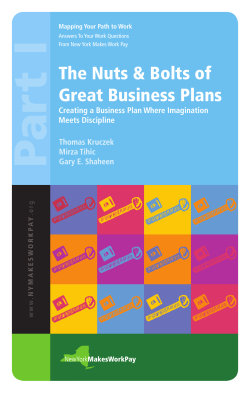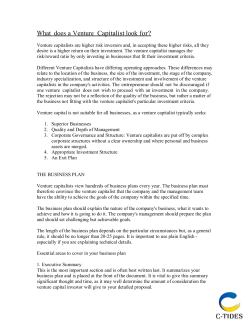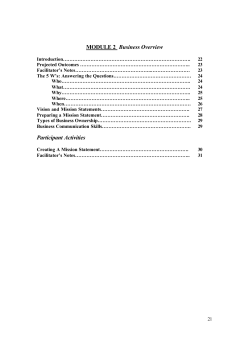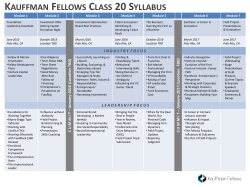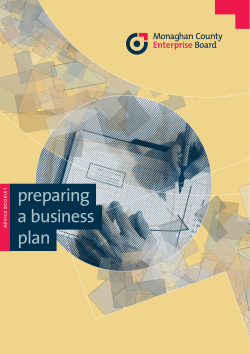
Camino Real Angel Network A QUICK GUIDE TO WRITING A BUSINESS PLAN
Camino Real Angel Network A QUICK GUIDE TO WRITING A BUSINESS PLAN FOR VENTURE FUNDING A complete business plan consists of the following sections: 1. 2. 3. 4. 5. 6. 7. 8. 9. 10. 11. Executive Summary Business Definition Market and Customer Analysis Product/Service Description Economics of the Business Strategy Marketing Product Development / Manufacturing Management Exit Strategy Financials A well-written plan should not exceed 20 pages, including executive summary, financials and exhibits. Detailed financial statements, product specifications, copies of patents, etc. should be included as appendices. Each section of the plan should convey specific information that is important to the investor: 1. Executive Summary: This section is probably the single most important section of the plan. The summary is intended to convey the essence of your plan. It needs to provide a clear, concise description of the business case that is contained in the pages of the plan. The Executive Summary generally should not exceed three to five pages, including exhibits and diagrams. Many venture firms and Angel groups will allow you to provide only the Executive Summary, prior to determining initial interest. In other cases, the Executive Summary may still be the only portion of your plan that gets read in an initial funding evaluation. It is important that you communicate the essence of how your venture will make money very early on, often on the first page. The following information should be included: a) b) c) d) e) f) g) h) 2. The market opportunity being addressed, its size and growth rate. The product or service being provided. The customer need or application. Key competitive advantages of the business, The results the business will achieve in terms of sales, profitability, and market position. The major strategic product/market actions you will employ to reach the intended targets. The amount of investment the business requires and what it will be used for, The exit strategy for the investor. Business Definition: This narrative section answers the question: "what business are you in?" It includes a description of the product or service offered by the business (what the customer will buy), the market and customers being served (who the target customer is), the need or application of the customer that your product addresses (why the customer buys), and the technology on which the product is based. This section should also include a description of the proprietary and competitive advantages of the business; that is, what makes the company's product/service unique. A key element in the plan is market segmentation. A segmentation must be strategically and conceptually useful, and subsequent actions should be tied to the identified market segments. Each segment should represent a group of customers having similar attributes that are separated from one another by a series of actual and/or psychological barriers. These barriers do exist in a market; they are characteristic traits of a market (or of a particular segment) that aid or impede the entry or defense of that market by any specific competitor. Barriers in a market are overcome by strengths of the particular competitors. It is important in planning strategy that you pair your strengths against relevant barriers, and that you explain your plan to correct weaknesses that may prevent you from effectively overcoming barriers. Some examples of more traditional barriers are: a) b) c) d) e) f) Geographical location of customers. Customer desire for proprietary product position. Price sensitivity of customer. Desire for technological/performance superiority. Capitalization requirements of the market. Psychological barriers. The barriers listed above are not the only barriers. The key is the proper direction of product introduction efforts toward segments most likely to yield success. 3. Market and Customer Analysis: This section identifies the key factors in the market that will be of strategic importance. It includes quantitative data about the size of the market and its customers. The following should be discussed for each targeted market: a. b. c. d. e. Short-term and long-term growth rates. Size in both units and dollars. Stability (how susceptible to change is the market, and growth rate). Major customer or customer types, the need or application being addressed, and key characteristics. Your company's advantages and disadvantages in the target market segment. This section of the plan also discusses the key competitors of the business. Limit your analysis to the two or three most significant competitors. For each competitor, analyze the apparent business strategy in the target segments, the competitor's strengths and weaknesses in addressing the segment, and the costs or prices of the competitor's products. 4. Product/Service Description: This section describes the products or services that the business intends to produce, including a description of the key features of the product or services. This description answers such key questions as: a. b. c. How does it work? This is a brief description, not a long technical dissertation. Why is it technologically significant? Is this the "killer app" to change the industry? What is the product's competitive advantage compared to other approaches to satisfying the customer's need? Does the product allow the customer to do something better, faster, cheaper? Additionally, if the product is based on proprietary technology, a description of the technology and how it is protected should be included in this section. Remember, a long technical explanation should be avoided. Features must create value for the customer; for industrial products, this typically means either increasing sales or lowering costs. 5. Economics of the Business: These are the key objectives of the business in the areas of revenue, profitability, breakeven, and cash flow. Targets should be established for the first year of business and for the end point of the company's planning horizon. There is little agreement about the length of the planning horizon. Most business plans typically project results for a five-year period. Ideally, a company would set its targets dependent upon how long it takes to implement key strategies. Regardless of the horizon, some discussion of projections beyond the targets should be included. To interest venture investors, projections should be large but realistic and defensible. Expect prospective investors to question every number and assumption. 6. Strategy: Outline those actions you will pursue in order to achieve the economic targets. The focus should be on the major marketing, product development, manufacturing, and organization programs. The strategies must be consistent with your market segmentation and should be directed toward those segments where you have identified the greatest possibility of success. A critical part of strategy is identifying key assumptions and specifying the contingent actions to be taken if assumptions prove erroneous. 7. Marketing: This section provides a realistic and well-documented plan for achieving the projected sales and market share. It discusses the targeted customers and sales strategy for reaching them. The names of existing or potential key customers should be listed. Other elements of the marketing strategy include: a. b. c. d. 8. Pricing policy and how the projected price compares with that of the competition. Sales and distribution covering the planned sales approach and the type and rationale for the selected channels of distribution. Service and warranty policies. Advertising, public relations, and promotion. Product Development / Manufacturing: This section should contain a schedule that shows completion dates for major milestones in the development of the product. Major technical breakthroughs required should be clearly identified. If outside organizations such as engineering are critical to the development of the product, their contribution should be identified. Included in this section is how the product will be produced, including location, plant and equipment, production processes, and labor, including: a. b. c. 9. Use of subcontractors, extent and capacity. Key suppliers. Quality programs. Management: Provide a biographical paragraph or two regarding the experience and capabilities of key members of the company's management team. Resumes should be included in an appendix. Also, provide an organizational chart identifying the overall corporate structure and key technical and managerial positions, and outline plans for filling vacancies of critical positions and the use of outside services. Investors typically want key positions filled with personnel experienced in similar roles. An inventor is not necessarily the automatic best choice as CEO, particularly if that person is well suited to being a CTO. Along with the idea and the market, a strong management team is often among the most important factors influencing the investor decision. 10. Exit Strategy: The plan must describe the method by which an equity investor in the company can receive a payback and exit the business relationship. In other words, how does an investor get a return on an investment. The most common exit strategies executed today by venture-backed companies is acquisition or merger. “Going public” is often the dream of new ventures, but very few companies actually achieve such a milestone. It is often best to present primary and secondary exit methods. 11. Financials: The financial expression of your plan for the next three to five years including an income statement, balance sheets, cash flow projections, and key financial projections. These tie in with the economic targets for the business. The amount of historical financial information needed in your business plan will depend largely on the state of the business and product development efforts. In many cases, the product will be developed by a start-up company with little or no financial performance history. The full-blown financial information can appear as the first section of your appendix. The business plan should describe the specific use of the funds needed. This section should describe the company's ownership, including sources and amounts of existing equity. REFERENCES 1. 2. 3. 4. 5. 6. 7. 8. The Entrepreneur's Guide To Preparing a Winning Business Plan and Raising Venture Capital - W. Keith Schilit. Written by a successful entrepreneur turned venture capitalist. New Venture Creation - Jeffrey D. Timmons. A detailed look at the entrepreneurial process written by one of the leading educators in the field. The Successful Business Plan: Secrets & Strategies - Rhonda M. Abrams. One of the best selling business plan guides, this book provides broad coverage of the subject and includes a number of excellent checklists. Business Planning for Scientists and Engineers - Jenny C. Servo and Paul D. Houler. Written for the DOE by two experienced practitioners in the technology commercialization process. An excellent section on market Start Up: An Entrepreneur’s Guide to Launching and Managing a New Business - A publication of The New Mexico Small Business Development Center, this guide identifies both requirements for starting a business in New Mexico as well as resources available to small companies. Business Plans that Win $$$ - Stanley Rich and David Gumpert. Based on the approaches of the MIT Enterprise Forum, this book uses examples from real business plans to answer questions about how to effectively present any product or service. High Tech Start Up - John L. Nesheim. Advice for the entrepreneur particularly interested in a technology-based business. The New Venture Handbook - Ronald Merrill and Henry Sedgwick. Written by experienced entrepreneurs, this book contains checklists and exercises to guide you through the key phases of starting a business. - Adapted from the Technology Ventures Corporation, A QUICK GUIDE TO WRITING A BUSINESS PLAN FOR THE TECHNOLOGY-BASED BUSINESS, November 1999.
© Copyright 2025


